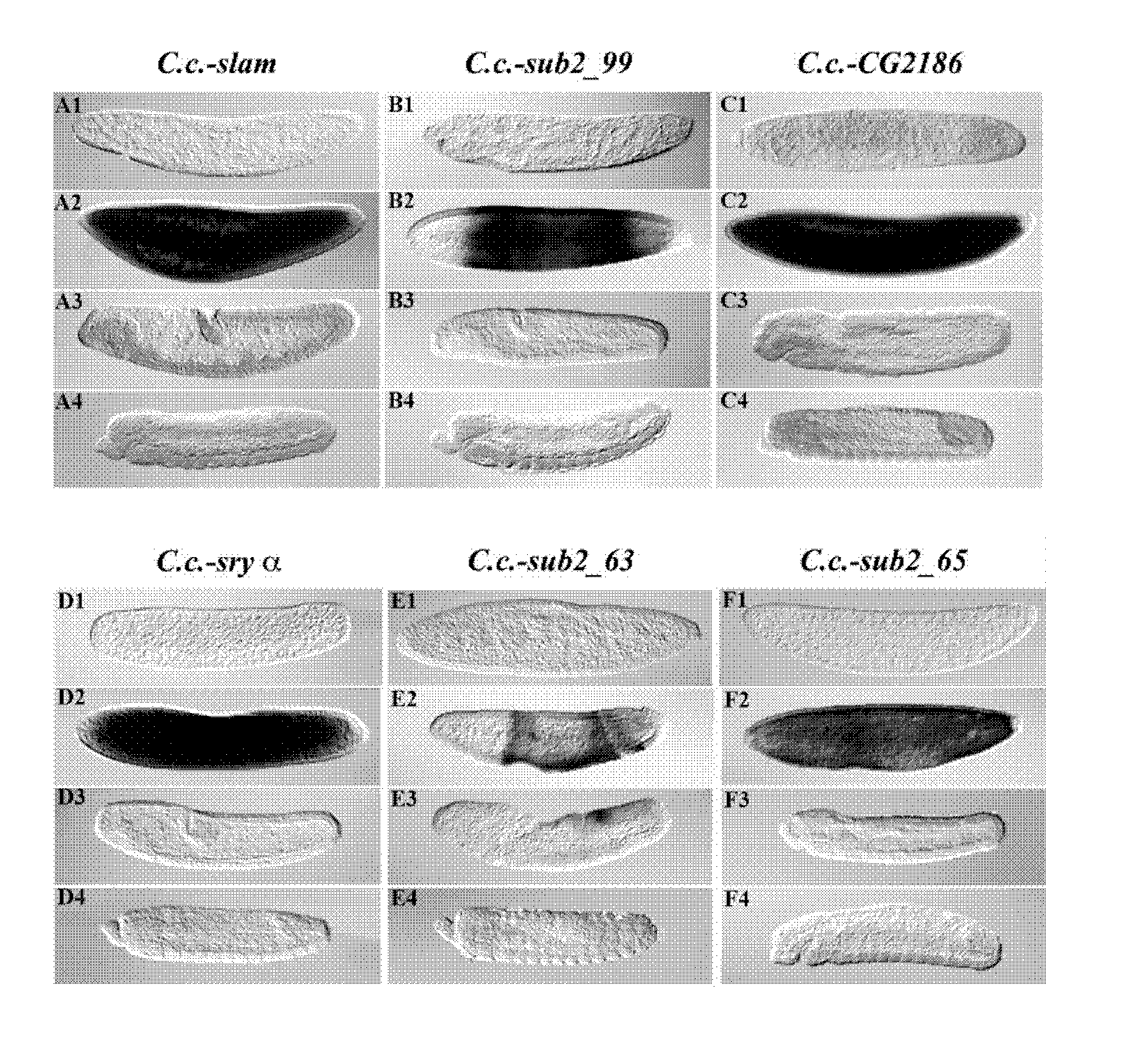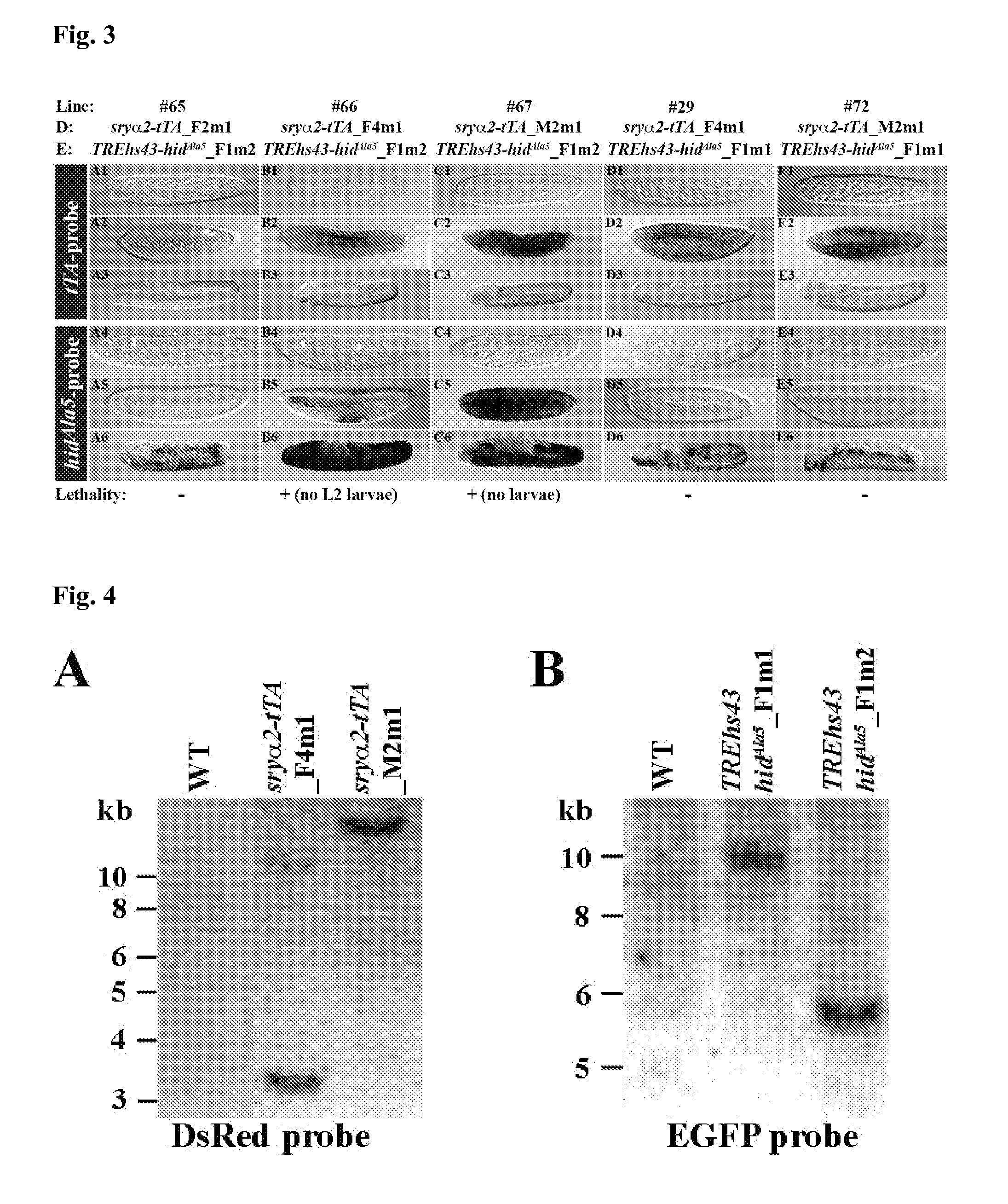Development stage-specific lethality system for insect population control
- Summary
- Abstract
- Description
- Claims
- Application Information
AI Technical Summary
Benefits of technology
Problems solved by technology
Method used
Image
Examples
example 1
Isolation of Cellularization-Specifically Expressed Genes and their P / Es from Medfly (C. capitata)
[0065]The Clontech PCR-Select cDNA Subtraction Kit (BD Biosciences, Heidelberg) was used to isolate fragments of the following genes expressed specifically during cellularization according to the techniques described in SCHETELIG (2007), which reference is herewith incorporated in its entirety: C.c.-slam, C.c.-sub2—99, C.c.-CG2186, C.c.-sub2—63, and C.c.-sub2—65. An EST fragment of the medfly cellularization gene serendipity α (C.c.-sry α) was received from Dr. Ludvik Gomulski, Pavia. By RACE, 5′ and 3′ ends of cellularization specific genes were isolated using the BD SMART RACE cDNA Amplification Kit (BD Biosciences, Heidelberg) and gene specific primers. Complete cDNA sequences are shown in SEQ ID NO. 6-11.
[0066]Inverse PCR was performed to obtain the 5′ regions of genes specifically expressed during cellularization: 1.5 μg of medfly WT genomic DNA was digested for 24 h; restriction f...
example 2
Construction of the Driver Constructs
[0067]Generally, constructs were prepared in the cloning shuttle vector pSLfa1180fa. From the shuttle vectors, the constructs can be easily placed in transformation vectors, which carry FseI and AscI sites (fa-sites; HORN AND WIMMER (2000)).
[0068]The pSLaf_attP-sl2-tTA_af (#1231), pSLaf_attP-63-tTA_af (#1232), pSLaf_attP-99-tTA_af (#1234), pSLaf_attP-sryα2-tTA_af (#1236) and pSLaf_attP-ccCG2186-tTA_af (#1237) carry a 52 bp attP site (THORPE (2000)). #1231, #1232, or #1234 was created by ligating annealed attP primers (mfs-201 / -202, SEQ ID NO. 49 and 50) in the EcoRI cut pSLaf_sl2-tTA_af (#1210), pSLaf—63-tTA_af (#1211) or pSLaf—99-tTA_af (#1212), respectively. #1236 or #1237 was created by ligating annealed attP primers (mfs-203 / -204, SEQ ID NO. 51 and 52) in the NcoI cut pSLaf_sryα2-tTA_af (#1225) or pSLaf_CG2186-tTA_af (#1226), respectively.
[0069]#1210, #1211, or #1212 was created by ligating the EcoRI-XbaI cut sl2 fragment (a 1.9 kb 5′-region ...
example 3
Construction of the Effector Constructs
[0074]The effector constructs pBac{fa_attP_f_TREp-hidAla5_a_PUb-EGFP} (TREp-hidAla5) or pBac{fa_attP_f_TREhs43-hidAla5_a_PUb-EGFP} (TREhs43-hidAla5) were generated by cloning the hybridized primers mfs-211 / -212 (SEQ ID NO. 53 and 54) in the XmaJI site of pBac{faf_TREp-hidAla5_a_PUb-EGFP} (#1207) or pBac{faf_TREhs43-hidAla5_a_PUb-EGFP} (#1208), respectively. #1207 or #1208 were created by ligating the AscI fragments TREp-hidAla5 (5.0 kb) or TREhs43-hidAla5 (4.9 kb) from pSLfa_TREp-hidAla5_fa or pSLfa_TREhs43-hidAla5_fa (HORN AND WIMMER (2003)) in the AscI site of pBac{fa_PUb-EGFP} #1201 (SCOLARI (2008)), respectively. The effector construct pBac{>fa_attP_f_TREp-hidAla5_a>_PUb-EGFP} (>TREp-hidAla5>) was generated by ligating the AscI-fragment attP_f_TREp-hidAla5 from TREp-hidAla5 in the AscI-site of pBac{>fa>_PUb-EGFP} (SCOLARI (2008)).
[0075]Three effector constructs were generated (TREp-hidAla5, TREhs43-hidAla5, and >TREp-hidAla5>) carrying the ...
PUM
| Property | Measurement | Unit |
|---|---|---|
| Digital information | aaaaa | aaaaa |
| Digital information | aaaaa | aaaaa |
| Gene expression profile | aaaaa | aaaaa |
Abstract
Description
Claims
Application Information
 Login to View More
Login to View More - R&D
- Intellectual Property
- Life Sciences
- Materials
- Tech Scout
- Unparalleled Data Quality
- Higher Quality Content
- 60% Fewer Hallucinations
Browse by: Latest US Patents, China's latest patents, Technical Efficacy Thesaurus, Application Domain, Technology Topic, Popular Technical Reports.
© 2025 PatSnap. All rights reserved.Legal|Privacy policy|Modern Slavery Act Transparency Statement|Sitemap|About US| Contact US: help@patsnap.com



